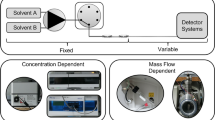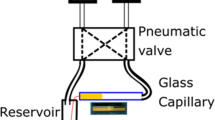Abstract
This paper describes an analytical three-capillary viscometer detector that eliminates the traditional viscometer “hold-up” volume (commonly found in four-capillary designs) while maintaining cancellation of short-term pump noise and long-term baseline drift of temperature and solvent flow rate that are inherent in chromatography systems. This improvement allows a staggered sample injection approach in chromatography, yielding a significant increase in sample throughput by cutting down the chromatographic run time. It also provides a more robust design as it does not require capillary rebalancing, complex purging, flushing or changing the hold-up volume to accommodate long-term chromatographic use.

Example of a four-capillary viscometer in a quad-detector GPC system.






Similar content being viewed by others
References
Lesec J, Millequant M, Havard T (1994) J Liq Chromatogr 17:1029–1055
Netopilik M et al (2000) Int J Polymer Anal Char 5(4–6):339–357
Lecacheux D et al (1984) Viscosimeter operating continuously especially at high temperature. US 4478071
de Corral JL (1997) Three capillary flow-through viscometer. US 5637790
Yau W (1988) Differential pressure capillary viscometer. US 4793174
Yau WW, Smith GA, and DeStefano JJ (1989) In: Int GPC Symp, pp 182–190, October, Newton, Massachusetts
Haney M (1985) J Appl Polymer Sci 30(7):3037–3049
Trainoff S, Wyatt Technology Corporation (2007) US 2007/006822
Trainoff S, Wyatt Technology Corporation (2006) US 2006/0213256
Author information
Authors and Affiliations
Corresponding author
Additional information
Published in the special issue Separation Science of Macromolecules with Guest Editor André Striegel
Appendices
Appendix A
Data processing for case 3 differential–differential two-capillary viscometer
A two-capillary viscometer with the differential–differential option (excerpts from W.W. Yau et al. [6])
The first attachment to this appendix below is a schematic showing a two-capillary viscometer with the differential–differential option used with a SEC system. In between the two capillaries, a detection-mode selection valve is installed to allow the selection of a large delay hold-up volume (comparable in volume to the total SEC column volume) to run the viscometer in the low-throughput mode, as discussed in case 1 in the main body of this paper. This large hold-up volume dilutes and delays the polymer solution before reaching the reference capillary, while the fractionated polymer sample solution is being detected in the analytical capillary. The viscometer signal from the voltage output of a differential log-amplifier gives the measure of the desired \( {\hbox{lo}}{{\hbox{g}}_{_{\rm{e}}}}{\eta_{_{\rm{rel}}}} \) value of the fractionated polymer sample in the SEC effluent, where \( {\eta_{_{\rm{rel}}}} \) is the symbol for relative viscosity.
In the differential–differential mode of the viscometer discussed above, the detection-mode selection valve is turned to the position of a much smaller delay volume (which can typically be around 100 μl). The reference capillary (DP3 in our proposed example, see Fig. 1) is now connected in effect directly to the analytical capillary (DP2 in our proposed example) with only a very small offset volume. With this configuration, SEC effluent passes through DP2 and then reaches DP3 a very short time later. Under this circumstance, the output from the log-amplifier of the viscometer now measures, not the SEC viscosity elution curve itself, but in effect, the slope of the viscosity elution profile. The baseline pump and temperature noise are considerably reduced in this log-amplifier signal. The desired SEC viscosity elution curve can however be recovered by the direct integration of the output of the log-amplifier.
By employing digital computing methods, the desired sample viscosity results can be obtained without the use of a log-amplifier. The second attachment below provides an explanation of the data processing steps and the basic principles of this viscometer configuration.


Appendix B
Data processing for case 2 high-pressure referencing two-capillary viscometer

Rights and permissions
About this article
Cite this article
Yau, W.W., Cong, R. & Gillespie, D. A high-throughput three-capillary noise-cancelling viscometer for chromatographic systems. Anal Bioanal Chem 399, 1563–1570 (2011). https://doi.org/10.1007/s00216-010-4182-x
Received:
Revised:
Accepted:
Published:
Issue Date:
DOI: https://doi.org/10.1007/s00216-010-4182-x




